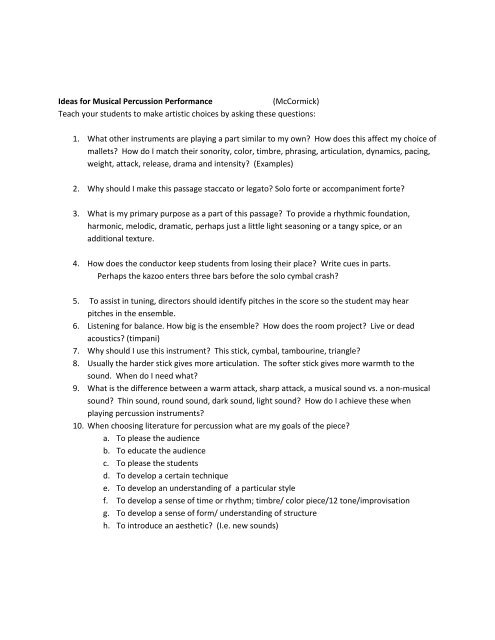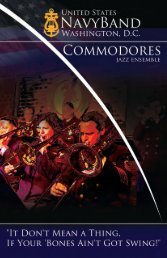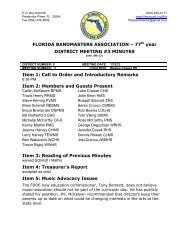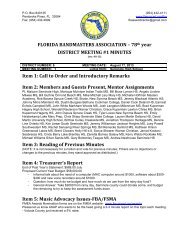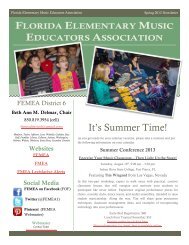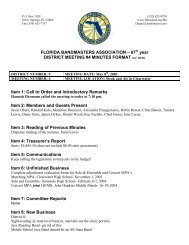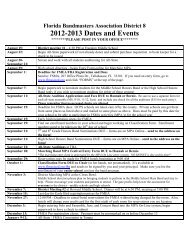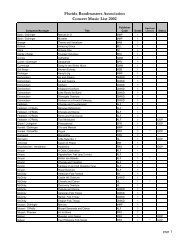Handout - Florida Music Educators Association and Florida School ...
Handout - Florida Music Educators Association and Florida School ...
Handout - Florida Music Educators Association and Florida School ...
Create successful ePaper yourself
Turn your PDF publications into a flip-book with our unique Google optimized e-Paper software.
Ideas for <strong>Music</strong>al Percussion Performance (McCormick)<br />
Teach your students to make artistic choices by asking these questions:<br />
1. What other instruments are playing a part similar to my own? How does this affect my choice of<br />
mallets? How do I match their sonority, color, timbre, phrasing, articulation, dynamics, pacing,<br />
weight, attack, release, drama <strong>and</strong> intensity? (Examples)<br />
2. Why should I make this passage staccato or legato? Solo forte or accompaniment forte?<br />
3. What is my primary purpose as a part of this passage? To provide a rhythmic foundation,<br />
harmonic, melodic, dramatic, perhaps just a little light seasoning or a tangy spice, or an<br />
additional texture.<br />
4. How does the conductor keep students from losing their place? Write cues in parts.<br />
Perhaps the kazoo enters three bars before the solo cymbal crash?<br />
5. To assist in tuning, directors should identify pitches in the score so the student may hear<br />
pitches in the ensemble.<br />
6. Listening for balance. How big is the ensemble? How does the room project? Live or dead<br />
acoustics? (timpani)<br />
7. Why should I use this instrument? This stick, cymbal, tambourine, triangle?<br />
8. Usually the harder stick gives more articulation. The softer stick gives more warmth to the<br />
sound. When do I need what?<br />
9. What is the difference between a warm attack, sharp attack, a musical sound vs. a non‐musical<br />
sound? Thin sound, round sound, dark sound, light sound? How do I achieve these when<br />
playing percussion instruments?<br />
10. When choosing literature for percussion what are my goals of the piece?<br />
a. To please the audience<br />
b. To educate the audience<br />
c. To please the students<br />
d. To develop a certain technique<br />
e. To develop an underst<strong>and</strong>ing of a particular style<br />
f. To develop a sense of time or rhythm; timbre/ color piece/12 tone/improvisation<br />
g. To develop a sense of form/ underst<strong>and</strong>ing of structure<br />
h. To introduce an aesthetic? (I.e. new sounds)
Bass Drum/Gran Cassa/Grosse Trommel, Grosse Caisse<br />
Tuning<br />
‐as low as possible without sounding flabby<br />
‐calf heads are especially nice for low sounds; Fiberskyn 3<br />
‐beating head lower than vibrating head. Careful not to set up a pitch<br />
‐check for rattles in st<strong>and</strong>; T‐h<strong>and</strong>les; inside lugs etc.<br />
Striking areas<br />
‐use your ears for color<br />
‐just off center for general playing <strong>and</strong> a warm full tone<br />
‐closer to edge for light color <strong>and</strong> less articulation (thinner tone)<br />
‐center spot is the node; OK for dry canon shot<br />
‐notice backbone on head will be thicker<br />
Striking technique<br />
‐tight grip will give thin sound<br />
‐direct stroke <strong>and</strong> play off drum (avoids harshness of sound)<br />
‐relaxation is always the key to fluid technique<br />
‐arm action from shoulder <strong>and</strong> elbow offers better balance of beater<br />
‐grips for two mallet playing. (traditional works well)<br />
Muffling<br />
‐use h<strong>and</strong> <strong>and</strong> knee to muffle<br />
‐concert drum should be resonant. Muffle usually after stroke<br />
‐don’t use internal muffling. External muffling on occasion only<br />
‐valuation of the note in relation to the music<br />
Mallet choices<br />
‐Recommended br<strong>and</strong>s: Gauger <strong>and</strong> Putnam<br />
‐Mallet must have right characteristics of weight/mass to achieve the fundamental<br />
‐Sustain general purpose<br />
‐Legato <strong>and</strong> staccato for more point to the sound<br />
‐leather covered or chamois style<br />
‐rubber tubing works well over aluminum or wood for very articulate passages (Bass drum<br />
continued)
Bass Drum st<strong>and</strong>s<br />
‐finding one without rattles<br />
‐cradle vs. suspension<br />
Other musical considerations<br />
‐ideas for phrasing<br />
‐valuation of notes<br />
‐listening especially to low brass<br />
Important repertoire<br />
‐Prokofiev 5 th Symphony<br />
‐Stravinsky Rite of Spring; Firebird; Petrouska<br />
‐Verdi Requiem<br />
‐Berlioz Requiem<br />
‐Ravel Pictures<br />
‐Mahler 3 rd Symphony<br />
‐Tchaikovsky 4 th Symphony<br />
Cymbals (Piatti, Becken, Cymbales)<br />
Selection<br />
‐French‐light wispy‐ fairly short duration of vibration, when a little spice is needed<br />
‐Viennese are fuller sounding <strong>and</strong> general purpose<br />
‐Germanic are for a lot of point <strong>and</strong> ‘klang’. The spice is strong!!<br />
‐ Timbre can range from dark to bright. Heavy cymbals (also depending on angle of cymbal)<br />
may be brighter sounding. Experiment by trying different cymbals to achieve what works best<br />
for a particular excerpt. Ask the percussionist to try these cymbals. Conductor: “I need more<br />
definition to the sound” or “These are the most dramatic notes <strong>and</strong> this one is the climax, can<br />
you use the bigger cymbals here?” or “I would like a darker sound here. What could we try?”<br />
etc.<br />
Basic size: 18” For darker sound K symphonic <strong>and</strong> K Constantinople<br />
For brighter sound use A Zildjian line. 16”, 20” etc.
Triangle<br />
Basic fundamentals:<br />
‐how to get the ears working (listening to your crashes <strong>and</strong> those of others, recordings etc)<br />
‐a relaxed drop technique produces a warm full sound<br />
‐angles are needed to avoid air pockets. Cymbals sound ‘flam’<br />
‐bright sounds <strong>and</strong> dark sounds related to speed of attack <strong>and</strong> follow‐through<br />
‐sound may be darker more parallel to floor<br />
‐more perpendicular for higher overtones<br />
‐left h<strong>and</strong> more stationary for repeated fast notes <strong>and</strong> marches<br />
‐softer notes more perpendicular to floor<br />
‐louder strokes wider angle <strong>and</strong> distance<br />
‐floor exercise works well when beginning<br />
Suspended cymbals:<br />
‐don’t use h<strong>and</strong> cymbals<br />
‐lighter cymbals tend to work best‐ sizes 14‐18”<br />
‐muffling techniques (mallet, h<strong>and</strong>s, body)<br />
‐use cord mallets as opposed to timpani sticks.<br />
Basic cymbal repertoire:<br />
‐Tchaikovsky 4 th Symphony <strong>and</strong> Romeo & Juliet<br />
‐Rachmaninov 2 nd Piano Concerto<br />
‐Debussy Le Mer<br />
‐Rimsky‐Korsakov Scheherazade <strong>and</strong> Capriccio Espagnol<br />
Selection<br />
‐nice sizzle of non‐pitched overtones<br />
‐larger triangles provide easier execution<br />
‐various size beaters provide dynamic control<br />
‐suspension clip is critical<br />
‐not too much play with suspension system<br />
‐professional level instruments. (Grover Pro) (triangle cont)
Triangle Technique<br />
‐triangle should be h<strong>and</strong> held at eye level when possible<br />
‐strike at an angle usually on lower section<br />
‐soft delicate sounds best when played near tip of beater<br />
‐louder a little farther back<br />
‐usually best to allow the triangle to ring<br />
‐one <strong>and</strong> two beaters when appropriate<br />
Triangle repertoire<br />
‐Berlioz Roman Carnival Overture<br />
‐Brahms 4 th Symphony<br />
‐Liszt Piano Concerto in E Flat<br />
‐Rimsky‐Korsakov Scheherazade <strong>and</strong> Capriccio Espagnol<br />
Tambourine (tambour de basque, tambourin, tamburo basco)<br />
Selection<br />
‐Grover Beryllium copper has warm jingle sound & new heads<br />
‐dry jingles for staccato<br />
‐st<strong>and</strong>ard size 10”<br />
Technique<br />
‐articulate when nearly horizontal <strong>and</strong> less so when perpendicular<br />
‐cradle for two h<strong>and</strong> <strong>and</strong> softer playing<br />
‐upside down etc<br />
‐between fist <strong>and</strong> knee<br />
‐finger roll <strong>and</strong> larger size instrument<br />
‐thumb roll to knee for accent<br />
‐up‐down 4 stroke ruffs<br />
‐samba wrist strokes<br />
‐shake roll with wrist, arm <strong>and</strong> shoulder<br />
‐softer playing use 1 or 2 fingers<br />
‐closed fist for aggressive playing<br />
(tambourine cont)
Tambourine Repertoire<br />
Dvorak Carnival Overture<br />
Berlioz Roman Carnival Overture<br />
Bizet Carmen<br />
Tchaikovsky Nutcracker<br />
Stravinsky Petrouchka<br />
Other topics to be discussed:<br />
Snare drums, keyboard percussion, timpani<br />
Selection of marimba mallets: graduated approach works best (Yarn)<br />
Selection of timpani mallets: soft mallets for rolls in low pitches<br />
soft mallets for warm full bodied sound any dynamic<br />
harder mallets needed for soft articulate passages (also loud)<br />
Recommended general percussion text:<br />
Percussion for <strong>Music</strong>ians by Robert McCormick ( Warner Bros/Alfred) $16.95<br />
Teaching Percussion by Gary Cook (Schirmer) $98.95<br />
Percussion: A Course Study by Tom Siwe (Media Press) $34.50<br />
<strong>Music</strong>al percussion performers will only develop if the student is continually exposed to the best<br />
literature of all periods, styles from pre Baroque to post Schoenberg, Ligeti, Xenakis etc. if<br />
students only play groove music, repetitive chord progressions or the famous ostinato pieces,<br />
their sense of creativity is probably going to be limited. Let’s make them great listeners as well!!<br />
John Cage: “what we hear is mostly noise. When we ignore it, it disturbs us. When we listen to<br />
it, we find it fascinating.” From “The Rest is Noise” by Alex Ross, a highly recommended text<br />
which teaches us to listen.
Short listed of recommended Percussion Solo <strong>and</strong> Ensembles:<br />
Snare solo‐<br />
Three Dances………………………………………………………………Warren Benson<br />
American Suite…………………………………………………………….Guy Gauthreau<br />
Douz Etudes…………………………………………………………………J. Delecluse<br />
Variations for Solo Snare……………………………………………..D. Henslick<br />
Noble <strong>and</strong> Coley Collections…………………………………………ed. By S. Smith<br />
Portraits of a Waltz*…………………………………………………….R. McCormick<br />
*First prize 2006 Keystone Composition Competition<br />
Timpani solo‐<br />
Eight Pieces for Unaccompanied Timpani………………………Elliot Carter<br />
Soundings………………………………………………………………………Doug Iglesrud<br />
Two Pieces for Unaccompanied Timpani………………………..Robert McCormick<br />
Fanfare Variations for Solo Timpani………………………………..Robert McCormick<br />
Three Dances for Solo Timpani………………………………………..Robert McCormick<br />
Marimba or mallet solo‐<br />
Concerto in A minor…………………………….............................Bach/Goldenberg<br />
Unaccompanied Violin Sonatas, Partitas, Cello Suites………Bach<br />
Japanese Marimba Solos Vol. I,II………………………………………Miki <strong>and</strong> various<br />
Frogs, Dream of Cherry Blossoms…………………………………….Keiko Abe<br />
Concertino for Marimba…………………………………………………..Paul Creston<br />
Soli from Zeltsman Marimba Method………………………………Nancy Zeltsman<br />
Percussion Ensemble:<br />
Canticle No. 1, Song of Quetzcoatl, Suite…………………………..Lou Harrison<br />
1 st Construction (also 3 rd , very advanced)………………………….John Cage<br />
Timecraft……………………………………………………………………………Hilton Jones<br />
Ogoun Badagris, Ku‐Ka‐Ilimoku,Bonham…………………………..Chris Rouse<br />
Toccata, Tambuco……………………………………………………………….Carlos<br />
Chavez
Upcoming dates:<br />
McCormick’s Magic Marimba Festival January 29‐30, 2010<br />
Bob McCormick, host<br />
Admission Free <strong>and</strong> all welcome.<br />
<strong>School</strong>s who have accepted for 2010 pending funding approval:<br />
University of Colorado<br />
Portl<strong>and</strong> State University (Oregon)<br />
Indiana University of Pennsylvania<br />
Westchester University of Pennsylvania<br />
University of Delaware<br />
Among The Previous schools that have been featured:<br />
Boston Conservatory<br />
University of Miami<br />
University of Maryl<strong>and</strong><br />
University of <strong>Florida</strong><br />
University of Central <strong>Florida</strong><br />
William Paterson University of New Jersey<br />
Louisiana State University<br />
Georgia State University<br />
Many <strong>Florida</strong> High <strong>School</strong> Groups<br />
The McCormick Marimba Festival was designed to further performance opportunities, study <strong>and</strong><br />
literature for the marimba <strong>and</strong> keyboard percussion.


